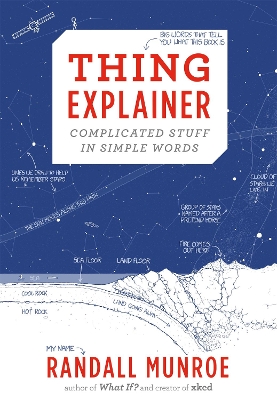
From the No. 1 bestselling author of What If? - the man who created xkcd and explained the laws of science with cartoons - comes a series of brilliantly simple diagrams ('blueprints' if you want to be complicated about it) that show how important things work: from the nuclear bomb to the biro.
It's good to know what the parts of a thing are called, but it's much more interesting to know what they do. Richard Feynman once said that if you can't explain something to a first-year student, you don't really get it. In Thing Explainer, Randall Munroe takes a quantum leap past this: he explains things using only drawings and a vocabulary of just our 1,000 (or the ten hundred) most common words.
Many of the things we use every day - like our food-heating radio boxes ('microwaves'), our very tall roads ('bridges'), and our computer rooms ('datacentres') - are strange to us. So are the other worlds around our sun (the solar system), the big flat rocks we live on (tectonic plates), and even the stuff inside us (cells). Where do these things come from? How do they work? What do they look like if you open them up? And what would happen if we heated them up, cooled them down, pointed them in a different direction, or pressed this button?
In Thing Explainer, Munroe gives us the answers to these questions and many, many more. Funny, interesting, and always understandable, this book is for anyone -- age 5 to 105 -- who has ever wondered how things work, and why.
- ISBN10 1473620910
- ISBN13 9781473620919
- Publish Date 24 November 2015
- Publish Status Out of Print
- Out of Print 26 October 2022
- Publish Country GB
- Publisher John Murray Press
- Imprint John Murray Publishers Ltd
- Edition Illustrated edition
- Format Hardcover
- Pages 64
- Language English
Reviews


MurderByDeath
This must have been a bitch to edit.
I bought this sight unseen (or asked for it on my xmas list anyway) based on my adoration for his first book What If? Thing Explainer is much shorter - only 60 pages - and the concept is very cool; explain how some of the most common things work.
What I didn't realise is that Munroe went into this book determined to use only the "top 10 hundred" words used in the English language (he determined this based on a number of factors, which he explains at the end of the book, in the section where he lists all the words). He explains why he chose to do this at the beginning of the book.
I love the concept and it doesn't sound like that big a deal on the surface of it; until you actually try to read how, say, a dishwasher works and it's titled "Box that Cleans Food Holders" or the page that explains how the "Big Tiny Thing Hitter" works (that's a particle collider to you and I). It's sort of fun trying to figure out what some of the entries are but reading the whole thing becomes rather tedious and ultimately I skimmed through it, reading bits here and there and laughing at the little comic asides that make me such a fan of Munroe. Some of the entries though, would be a great start at explaining some of the easier concepts to small kids (there's an entry for a tree, for example).
I especially love his explanation of the Constitution of the United States. Ultimately, it's a fun book, but I would have loved this book had he written it in this same style, but didn't try to limit himself to just the 1000 most common words (which oddly enough do not include "nine").
